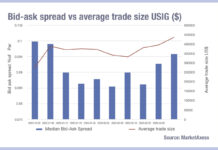The European Securities and Markets Authority (ESMA) launched consultations on 3 February 2020 for the regime for non-equity instrument systematic internalisers (SIs), venues that let market makers trade directly with clients on a bilateral basis, and on 4 February 2020 on the transparency regime for equity / equity-like instruments.
The former poses a wide range of questions regarding the SI regime, which it observes in many places is ‘overly complex’. The regime obliges SIs to make public firm quotes if they are trading bonds or other non-equity instruments for which there is a liquid market when either asked to by a client and when they agree to provide a quote. They do not have to publish price pre-trade if the trade size is higher than the ‘Size Specific to the Instrument‘ (SSTI), a level set annually on a per bond-type basis.
ESMA found that quoting activity for bonds is balanced between ‘liquid’ and ‘illiquid’ instruments as defined under the regulatory technical standards (RTS) while trading activity mainly takes place on liquid instruments which it observes indicates a reasonable discrimination between liquid and illiquid bonds as per the RTS. It also found that activity around the SSTI threshold was limited suggesting there was limited to no effort to game the current regime, with most trades occurring above the SSTI.
“There is general concern that we shouldn’t be doing anything too dramatic, because we are still getting the implementation right,” noted one observer, speaking on condition of anonymity. “When we are looking at fixed income, no one can truly understand what the quantitative nature of the impacts would be, because we are still embedding and going through the biggest piece financial regulation ever to hit this world.”
In the fixed income space MiFID II is seen to have failed in its promise to deliver greater transparency. It has demanded that trades are reported, however the general view is that this reporting is generating little value so far, with many transactions double reported to avoid a failure to comply with the rules. The consultation asks specifically how reporting from SIs and other sources might be changed and improved.
“The rules are that if you are selling, you report the transaction, but if you are buying and the person selling is not an SI, what do you do?” asks one trader, wishing to stay anonymous. “You don’t get any fines for over-reporting, you get fines for under-reporting, so ESMA are inundated with data. The data is not standardised and ESMA doesn’t really make it available, so no one can really use it.”
There have been a number of challenges around the quality of MiFID data more broadly, which can be split across different areas.
“Firstly, there is the potential input issues across firms, because regulation involves interpretation and people have different views,” says a sell-side expert. “So that needs to be worked through. Secondly is the way this information is being reviewed and that impacts the transparency. For example, looking at fixed income transparency the true impact of it hasn’t really been realised because accessible data is not really there.”

The latter consultation on the transparency regime for equities is proposing changes which are “intended to assist in the delivery of a Consolidated Tape for equities — again in order to improve transparency,” wrote Rebecca Healey, global head of Market Structure & Strategy at block trading firm Liquidnet, in an accompanying analyst note.
Buy-side traders note that there are some inconsistencies in the goals of the EC and its approach. For example, the predatory trading behaviour the EC has voiced concerns over historically is more prevalent in lit markets.
“The ESMA proposals are not stating that dark trading cannot continue in its entirety, but that activity which could return to lit continuous markets should, in order to improve transparency,” wrote Healey. “To that end, ESMA proposes to restrict dark trading waivers to large-in-scale (LIS) and order management facility (OMF) [waivers] to reduce the complexity of pre-trade transparency waivers and to improve overall transparency.”
However, frustration with ESMA’s approach to increasing transparency is showing, particularly where plans for transparency such as the consolidated tape – first proposed in 2011 – are taking time to develop.
“Why don’t they put their money where their mouth is, build a tape and make it commercially available – as the FINRA does in the US – and use that to help pay for the cost of ESMA?” asks one sell-side trader.
The SI regime consultation will run until ESMA 18 March 2020, and the transparency regime for equity/equity-like instruments until 17 March 2020.
All contributions should be submitted online at www.esma.europa.eu under the heading ‘Your input – Consultations’.
©The DESK 2020


























